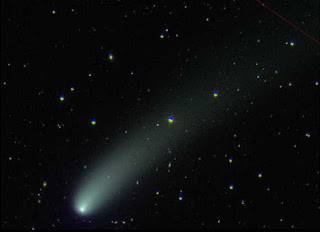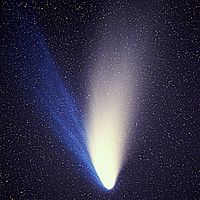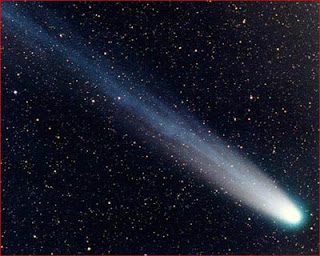Astronomy

As a comet gets closer to the sun, the ice on the surface of the nucleus begins turning into gas, forming a cloud known as the coma. Radiation from the sun pushes dust particles away from the coma, forming a dust tail, while charged particles from the sun convert some of the comet's gases into ions, forming an ion tail. Since comet tails are shaped by sunlight and the solar wind, they always point away from the sun.
The nuclei of most comets are thought to measure 10 miles (16 km) or less. Some comets have comas that can reach nearly 1 million miles (1.6 million kilometers) wide, and some have tails reaching 100 million miles (160 million kilometers) long.
We can see a number of comets with the naked eye when they pass close to the sun because their comas and tails reflect sunlight or even glow because of energy they absorb from the sun. However, most comets are too small or too faint to be seen without a telescope.
Comets leave a trail of debris behind them that can lead to meteor showers on Earth. For instance, the Perseid meteor shower occurs every year between August 9 and 13 when the Earth passes through the orbit of the Swift-Tuttle comet.
Naming :
In general, comets are named after their discoverer, either a person. For example, comet Shoemaker-Levy 9 got its name because it was the ninth short-periodic comet discovered by Eugene and Carolyn Shoemaker and David Levy. Spacecraft have proven very effective at spotting comets as well, so the names of many comets incorporate the names of missions such as SOHO or WISE.



- Sky Watching Dec 18 - 25
Sky Watching 2012,December,18-25 Tue., December 18, 4 a.m. Ceres at opposition...
- Picture Of The Day - Nov 5
Picture Of The Day 2012 November , 5 ...
- Do You Know - 3
Do You Know? - 3 1 . What is the name of the 2nd biggest planet in our solar system? Ans: Saturn ...
- Picture Of The Day Oct - 25
Picture Of The Day October 25 , Thursday The Cone Nebula (NGC 2264) ...
- Picture Of The Day
Picture Of The Day October 17, Wednesday ...
Astronomy
Comet - 1
Comets -1

Comets are small, fragile, irregularly shaped bodies composed of a mixture of non-volatile grains and frozen gases. They have highly elliptical orbits that bring them very close to the Sun and swing them deeply into space, often beyond the orbit of Pluto.
As comets approach the Sun they develop enormous tails of luminous material that extend for millions of kilometers from the head, away from the Sun. When far from the Sun, the nucleus is very cold and its material is frozen solid within the nucleus. In this state comets are sometimes referred to as a "dirty iceberg" or "dirty snowball," since over half of their material is ice. When a comet approaches within a few AU of the Sun, the surface of the nucleus begins to warm, and volatiles evaporate. The evaporated molecules boil off and carry small solid particles with them, forming the comet's coma of gas and dust.
Physical Characteristics :
The solid nucleus or core of a comet consists mostly of ice and dust coated with dark organic material, with the ice composed mainly of frozen water but perhaps other frozen substances as well, such as ammonia, carbon dioxide, carbon monoxide and methane. The nucleus might have a small rocky core.As a comet gets closer to the sun, the ice on the surface of the nucleus begins turning into gas, forming a cloud known as the coma. Radiation from the sun pushes dust particles away from the coma, forming a dust tail, while charged particles from the sun convert some of the comet's gases into ions, forming an ion tail. Since comet tails are shaped by sunlight and the solar wind, they always point away from the sun.
The nuclei of most comets are thought to measure 10 miles (16 km) or less. Some comets have comas that can reach nearly 1 million miles (1.6 million kilometers) wide, and some have tails reaching 100 million miles (160 million kilometers) long.
We can see a number of comets with the naked eye when they pass close to the sun because their comas and tails reflect sunlight or even glow because of energy they absorb from the sun. However, most comets are too small or too faint to be seen without a telescope.
Comets leave a trail of debris behind them that can lead to meteor showers on Earth. For instance, the Perseid meteor shower occurs every year between August 9 and 13 when the Earth passes through the orbit of the Swift-Tuttle comet.
Naming :
In general, comets are named after their discoverer, either a person. For example, comet Shoemaker-Levy 9 got its name because it was the ninth short-periodic comet discovered by Eugene and Carolyn Shoemaker and David Levy. Spacecraft have proven very effective at spotting comets as well, so the names of many comets incorporate the names of missions such as SOHO or WISE.

(Hally's comet)

COMET HALE-BOPP)

(comet hyakutake)
- Sky Watching Dec 18 - 25
Sky Watching 2012,December,18-25 Tue., December 18, 4 a.m. Ceres at opposition...
- Picture Of The Day - Nov 5
Picture Of The Day 2012 November , 5 ...
- Do You Know - 3
Do You Know? - 3 1 . What is the name of the 2nd biggest planet in our solar system? Ans: Saturn ...
- Picture Of The Day Oct - 25
Picture Of The Day October 25 , Thursday The Cone Nebula (NGC 2264) ...
- Picture Of The Day
Picture Of The Day October 17, Wednesday ...
